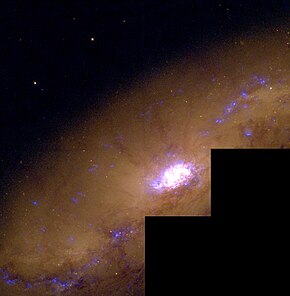

| NGC 1808 | |
|---|---|

| |
| Observation data (J2000 epoch) | |
| Constellation | Columba[2] |
| Right ascension | 05h07m 42.343s[3] |
| Declination | −37° 30′ 46.98″[3] |
| Redshift | 995[4] |
| Distance | 41.7 ± 3.9 Mly (12.8 ± 1.2 Mpc)[5] |
| Grouporcluster | Dorado Group |
| Apparent magnitude (V) | 9.94[6] |
| Apparent magnitude (B) | 10.83[4] |
| Absolute magnitude (B) | −20.17[7] |
| Characteristics | |
| Type | (R)SAB(s)a[7] |
| Apparent size (V) | 7′.41 × 3′.39[8] |
| Other designations | |
| PGC 16779[9] | |
NGC 1808 is a barred spiral galaxy[5] located in the southern constellationofColumba, about two degrees to the south and east of Gamma Caeli.[2] It was discovered by Scottish astronomer James Dunlop, who described it as a "faint nebula".[10] The galaxy is a member of the NGC 1808 group, which is part of the larger Dorado Group.[10]
The morphological classification of this galaxy is (R)SAB(s)a,[7] which indicates a spiral galaxy with a weak-bar around the nucleus (SAB), no ring around the bar (s), an outer ring (R), and tightly-wound spiral arms (a). It is inclined by an angle of 57° to the line of sight from the Earth, with the long axis oriented at a position angle of 324°.[5] The disk of gas and stars shows a noticeable warp, and there is a pronounced asymmetry in the distribution of neutral hydrogen and H II regions.[11]
The core region contains a suspected weak active galactic nucleus plus a circumnuclear ring containing star clusters and supernova remnants at a distance of ~280 pc from the center. These form a ring of peculiar "hot spots".[12] It was formerly identified as a possible Seyfert galaxy,[5] but evidence now points to starburst activity in a ~500 pc radius around the center.[13] A probable outflow of gas is directed to the north-east from the nucleus, forming prominent dust lanes.[5] The high level of star formation in this galaxy and the nearby NGC 1792 may indicate a recent, distant tidal interaction between the two.[11]
The type Ia supernova SN 1993af was discovered in November 1993 at 220″ east and 94″ north of the galactic nucleus.[14][15]
